Researchers observed “statistically significant increases” in mortality rates of all cancers, especially estrogen-related cancers, following mass vaccination with the third mRNA COVID-19 vaccine, according to a recent paper.
Japan has the highest vaccination rates, and is now conducting mass vaccinations with a seventh vaccine dose. According to the researchers, after mass vaccination began in 2021, there was a noticeable increase in cancer mortalities coinciding with the first and second COVID-19 vaccine doses.
Following vaccination with a third mRNA vaccine dose in 2022, researchers observed “significant excess mortalities” for all cancers and specifically estrogen and estrogen receptor alpha (ERα)-sensitive cancers, including ovarian, leukemia, prostate, lip/oral/pharyngeal, pancreatic, and breast cancers. Notably, breast cancer had a “significant deficit mortality” in 2020 but shifted to excess mortality in 2022 following the rollout of the third vaccine dose.
Other than pancreatic cancer, which was steadily rising before the pandemic, the other five types of cancers were on a downward trend. Still, all six types of cancers exceeded predicted mortality values in 2021, 2022, or during both years.

